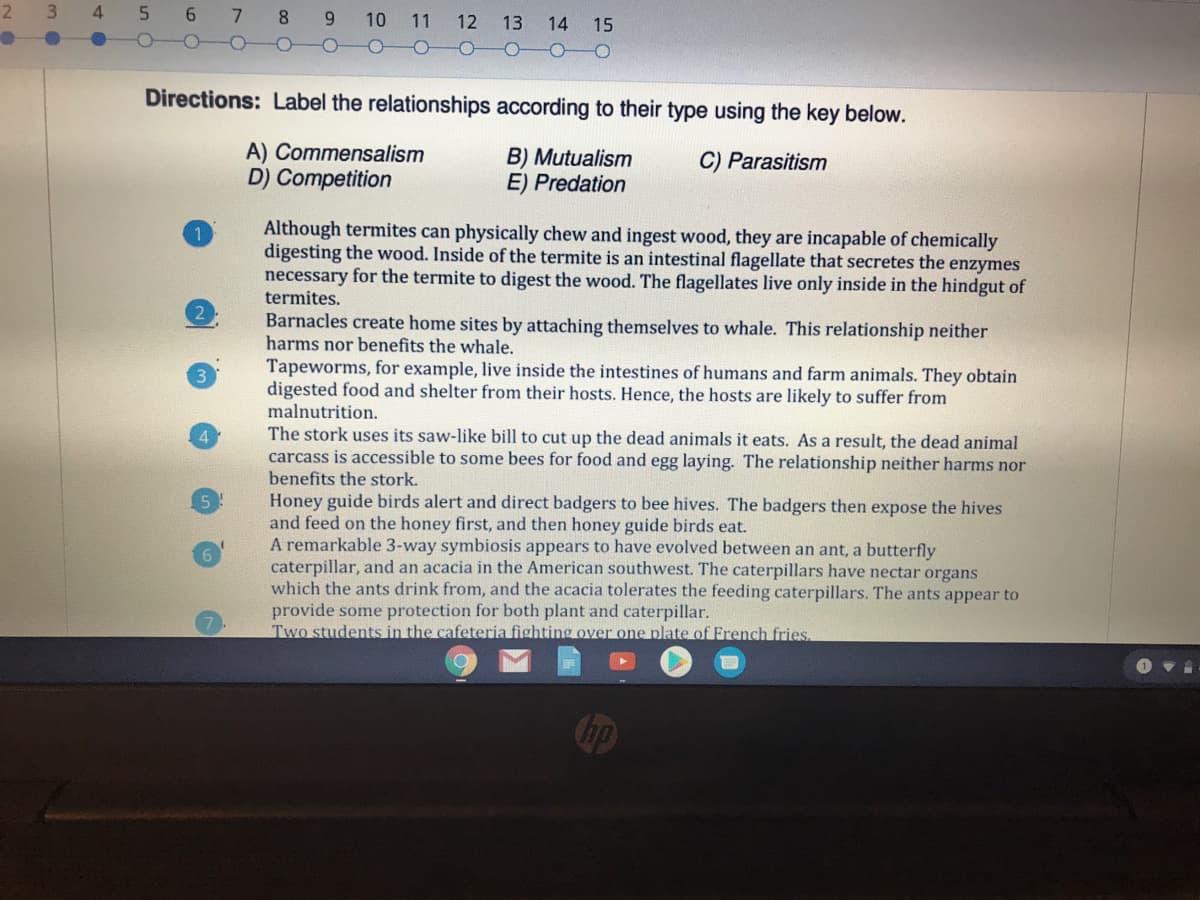A) Commensalism D) Competition B) Mutualism E) Predation C) Parasitism Although termites can physically chew and ingest wood, they are incapable of chemically digesting the wood. Inside of the termite is an intestinal flagellate that secretes the enzymes necessary for the termite to digest the wood. The flagellates live only inside in the hindgut of termites. Barnacles create home sites by attaching themselves to whale. This relationship neither harms nor benefits the whale. Tapeworms, for example, live inside the intestines of humans and farm animals. They obtain digested food and shelter from their hosts. Hence, the hosts are likely to suffer from malnutrition. The stork uses its saw-like bill to cut up the dead animals it eats. As a result, the dead animal carcass is accessible to some bees for food and egg laying. The relationship neither harms nor benefits the stork. Honey guide birds alert and direct badgers to bee hives. The badgers then expose the hives and feed on the honey first, and then honey guide birds eat. A remarkable 3-way symbiosis appears to have evolved between an ant, a butterfly caterpillar, and an acacia in the American southwest. The caterpillars have nectar organs which the ants drink from, and the acacia tolerates the feeding caterpillars. The ants appear to provide some protection for both plant and caterpillar. Two students in the cafeteria fighting over one plate of French fries.
A) Commensalism D) Competition B) Mutualism E) Predation C) Parasitism Although termites can physically chew and ingest wood, they are incapable of chemically digesting the wood. Inside of the termite is an intestinal flagellate that secretes the enzymes necessary for the termite to digest the wood. The flagellates live only inside in the hindgut of termites. Barnacles create home sites by attaching themselves to whale. This relationship neither harms nor benefits the whale. Tapeworms, for example, live inside the intestines of humans and farm animals. They obtain digested food and shelter from their hosts. Hence, the hosts are likely to suffer from malnutrition. The stork uses its saw-like bill to cut up the dead animals it eats. As a result, the dead animal carcass is accessible to some bees for food and egg laying. The relationship neither harms nor benefits the stork. Honey guide birds alert and direct badgers to bee hives. The badgers then expose the hives and feed on the honey first, and then honey guide birds eat. A remarkable 3-way symbiosis appears to have evolved between an ant, a butterfly caterpillar, and an acacia in the American southwest. The caterpillars have nectar organs which the ants drink from, and the acacia tolerates the feeding caterpillars. The ants appear to provide some protection for both plant and caterpillar. Two students in the cafeteria fighting over one plate of French fries.
Human Anatomy & Physiology (11th Edition)
11th Edition
ISBN:9780134580999
Author:Elaine N. Marieb, Katja N. Hoehn
Publisher:Elaine N. Marieb, Katja N. Hoehn
Chapter1: The Human Body: An Orientation
Section: Chapter Questions
Problem 1RQ: The correct sequence of levels forming the structural hierarchy is A. (a) organ, organ system,...
Related questions
Question


Transcribed Image Text:A) Commensalism
D) Competition
B) Mutualism
E) Predation
C) Parasitism
Although termites can physically chew and ingest wood, they are incapable of chemically
digesting the wood. Inside of the termite is an intestinal flagellate that secretes the enzymes
necessary for the termite to digest the wood. The flagellates live only inside in the hindgut of
termites.
Barnacles create home sites by attaching themselves to whale. This relationship neither
harms nor benefits the whale.
Tapeworms, for example, live inside the intestines of humans and farm animals. They obtain
digested food and shelter from their hosts. Hence, the hosts are likely to suffer from
malnutrition.
The stork uses its saw-like bill to cut up the dead animals it eats. As a result, the dead animal
carcass is accessible to some bees for food and egg laying. The relationship neither harms nor
benefits the stork.
Honey guide birds alert and direct badgers to bee hives. The badgers then expose the hives
and feed on the honey first, and then honey guide birds eat.
A remarkable 3-way symbiosis appears to have evolved between an ant, a butterfly
caterpillar, and an acacia in the American southwest. The caterpillars have nectar organs
which the ants drink from, and the acacia tolerates the feeding caterpillars. The ants appear to
provide some protection for both plant and caterpillar.
Two students in the cafeteria fighting over one plate of French fries.
Expert Solution
This question has been solved!
Explore an expertly crafted, step-by-step solution for a thorough understanding of key concepts.
This is a popular solution!
Trending now
This is a popular solution!
Step by step
Solved in 2 steps

Knowledge Booster
Learn more about
Need a deep-dive on the concept behind this application? Look no further. Learn more about this topic, biology and related others by exploring similar questions and additional content below.Recommended textbooks for you

Human Anatomy & Physiology (11th Edition)
Biology
ISBN:
9780134580999
Author:
Elaine N. Marieb, Katja N. Hoehn
Publisher:
PEARSON

Biology 2e
Biology
ISBN:
9781947172517
Author:
Matthew Douglas, Jung Choi, Mary Ann Clark
Publisher:
OpenStax

Anatomy & Physiology
Biology
ISBN:
9781259398629
Author:
McKinley, Michael P., O'loughlin, Valerie Dean, Bidle, Theresa Stouter
Publisher:
Mcgraw Hill Education,

Human Anatomy & Physiology (11th Edition)
Biology
ISBN:
9780134580999
Author:
Elaine N. Marieb, Katja N. Hoehn
Publisher:
PEARSON

Biology 2e
Biology
ISBN:
9781947172517
Author:
Matthew Douglas, Jung Choi, Mary Ann Clark
Publisher:
OpenStax

Anatomy & Physiology
Biology
ISBN:
9781259398629
Author:
McKinley, Michael P., O'loughlin, Valerie Dean, Bidle, Theresa Stouter
Publisher:
Mcgraw Hill Education,

Molecular Biology of the Cell (Sixth Edition)
Biology
ISBN:
9780815344322
Author:
Bruce Alberts, Alexander D. Johnson, Julian Lewis, David Morgan, Martin Raff, Keith Roberts, Peter Walter
Publisher:
W. W. Norton & Company

Laboratory Manual For Human Anatomy & Physiology
Biology
ISBN:
9781260159363
Author:
Martin, Terry R., Prentice-craver, Cynthia
Publisher:
McGraw-Hill Publishing Co.

Inquiry Into Life (16th Edition)
Biology
ISBN:
9781260231700
Author:
Sylvia S. Mader, Michael Windelspecht
Publisher:
McGraw Hill Education